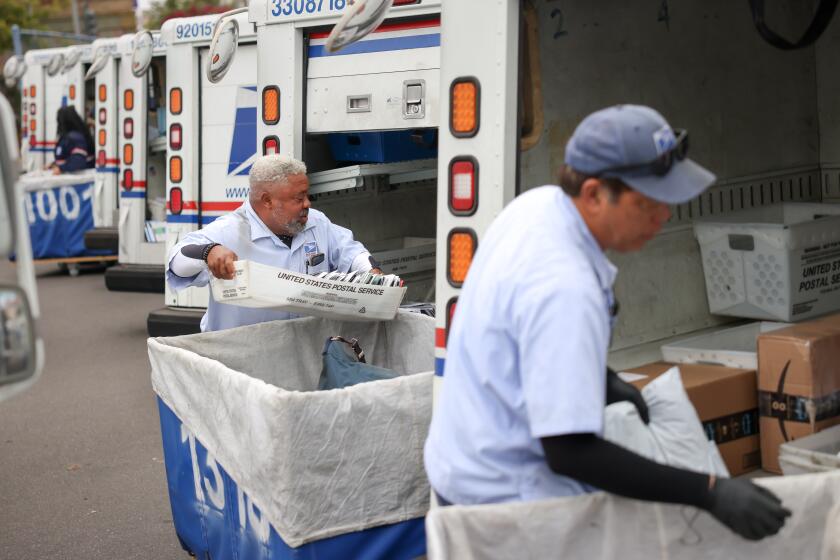‘Pocahontas’ Soars as Indians Struggle
- Share via
On Monday morning, as thousands of kids were just waking up from their Pocahontas dreams with Pocahontas candy-bar hangovers, the American Indian Clinic in Bellflower was opening for the business day.
Telephone the clinic, and what you hear on hold is bird song and a fluttering, keening flute; it is pleasant to listen to if you must spend any time waiting, which you might, because this place, like every other struggling health clinic in Los Angeles County, is short on staff and money, short on everything but demand.
So why write about this one?
Because “Pocahontas,” the animated film starring an American Indian princess, did a cool $29.5 million at the box office in its first weekend out, and that was apart from the collateral take on Pocahontas mugs and stickers and sunscreen, Pocahontas kids’ burger meals, pajamas, trading cards and chocolate bars.
Because $29.5 million, even $6 and $7 at a time, is probably close to the sum this clinic has operated on in all its 26 years under county and state and federal funding. Because a fragment of $29.5 million made in one weekend by a celluloid Indian would be mighty sweet to the thousands of real Indians who come to this clinic each year from Compton and Huntington Park and Bell and Long Beach, from as far away as Ventura and Orange County.
The irony of juxtaposition is hardly groundbreaking journalism. It is, though, another way to frame the question of guns vs. butter, millions for defense but not one cent for tribute, millions for chrome rims but not one cent for school crossing guards. Particularly at a time when Los Angeles County is talking of closing down its flagship hospital, and the sheriff is making noises about suing if his budget is cut, it is still a point worth making.
This Friday, two days hence, clinic director Richard Bouchard says, they face losing their federal $1 million from Indian Health Services, and perhaps more than that in matching funds, from a budget of $3.5 million.
Theirs is a complex dispute over the 1990 Census count, which showed about 30,000 fewer Native Americans in the county than 1980--something Bouchard disputes--as well as over quality improvement and peer review. As Bouchard puts it: When you lose money, you lose staff; when you lose staff, people raise questions about care, then you stand to lose more money.
And although Bouchard says their congressman, Steve Horn, is seeing what he can do, it all comes at a moment when Congress is considering cutting many purse strings to Indian services, upending the old quid pro quo of “trust responsibility”--our land in exchange for your perpetual care.
Window banners urge patients to clamor to save their clinic. They are Chumash and Cahuilla, Dakotah, Cherokee, Algonquin--a tribal melting pot like the region itself, which is why the clinic also welcomes Thais and Samoans and Latinos. Some 25,000 times a year, they seek out help from the mostly Native American staff for diabetes, breast cancer and nutrition. “Fry bread,” Bouchard says, making a face. “That’s not traditional. Those are the kinds of things we’re living on--they’re basically doughnuts.”
Bouchard remembers another Indian movie five years ago: “People said, ‘Yeah, Indians this and that, we’re sympathetic, we saw “Dances with Wolves.” ’ Yet that seven bucks you paid to get in the movie sure would have helped us.”
This is wishful thinking; he has no delusions that people will reorder their priorities so. Besides, Americans haven’t come to terms with history and conquest and guilt. How do we like our Indians? The noble savage or the savage savage? Tonto or Geronimo? Rich casino tribes or the persecuted Nez Perce? Surely not like Bouchard, who burns fragrant white sage in an abalone shell in his office. He is a Luiseno with eyes as blue as the loop of turquoise ribbon he wears on his luau shirt to support his clinic.
With “Pocahontas,” here we go again. “The romanticized version comes in, they expect you to look a certain way and talk a certain way or you’re not a real Indian,” like his former roommate, an actor and Native American who finally “had to change his name”--to something like Black Feather--”before anyone took him seriously.”
When his staff drive out to pick up donations for the clinic, the donor might say, “Oh wait, wait, I thought I was doing it for their Indian clinic. You’re not an Indian.”
They don’t fit the image. Pocahontas does--gratifyingly dark-haired and doe-eyed, at one with nature.
Dazzled by the film, we may be hard-pressed to remember that “Pocahontas” is based on a real woman who gained her first fame because of something that probably didn’t happen--saving Captain John Smith’s life, as fanciful a legend as Parson Weems’ tale of George Washington and the cherry tree.
Yet there are known truths about Pocahontas. Let it be recalled that she married John Rolfe, the first man to cultivate tobacco as a cash crop, and she probably died of tuberculosis.
Three hundred sixty-eight years after Pocahontas perished at age 23, Indians still die young, die of tobacco, of drinking, and TB.
More to Read
Sign up for Essential California
The most important California stories and recommendations in your inbox every morning.
You may occasionally receive promotional content from the Los Angeles Times.











